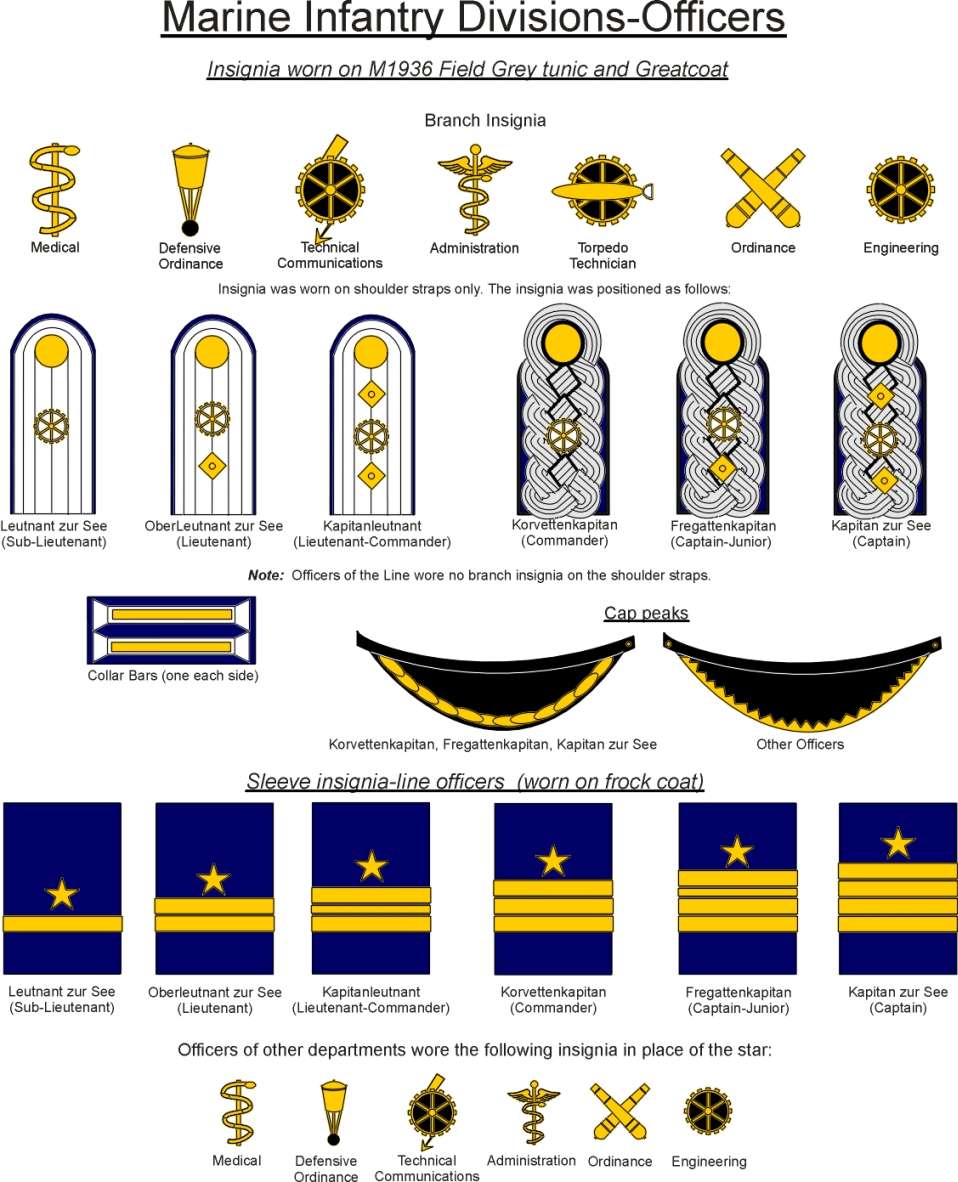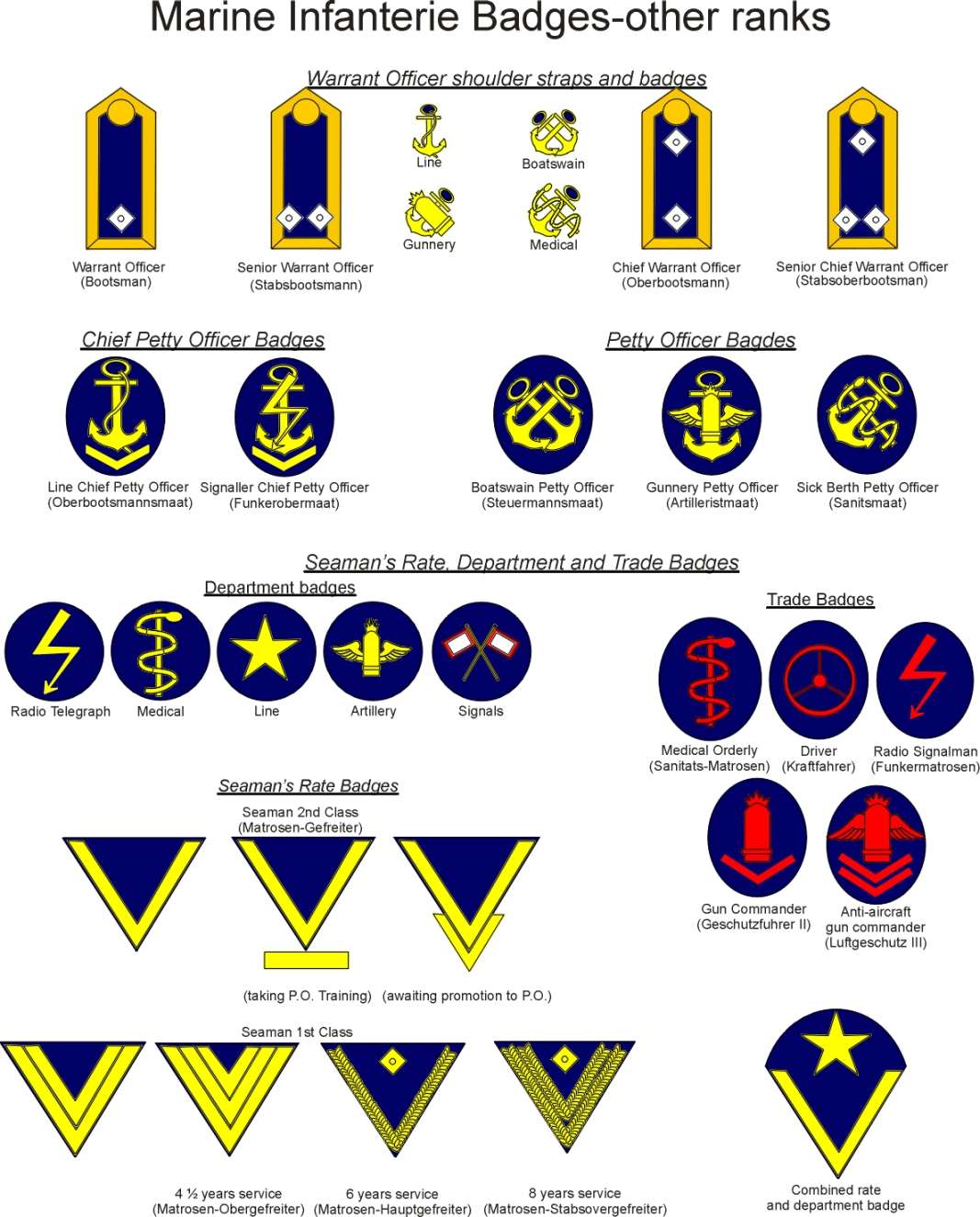

As the war turned against Germany, ships’ crews and shore support units were occasionally pressed into service to help defend ports in Russia and the Middle East. These were usually ad hoc units formed in the heat of the moment. In 1944 the first Marine-Infanterie-Division was formed on the North Sea coast using drafts from coastal defense personnel. They were organized like Wehrmacht divisions, and in many cases, were led by Wehrmacht officers and NCOs. Every effort was made to match the sea trade with its land-based equivalent; as a result, gunners were sent to the artillery, Sick Berth Attendants became medics, etc. This sped up the time needed to turn "anchor clankers" into front-line combat troops.
A total of five of these divisions were organized by the end of the war. The fate of each division is as follows:
1 Marine Infanterie Division -- deployed to the Eastern Front in February 1945, where it took up positions on the Oder River, some 60 kilometers east-northeast of Berlin. In May, it transferred to the Western Front, where they later surrendered to the Americans at the Scherin-Ludwigslust demarcation line, near the Elbe River east of Hamburg.
2 Marine Infanterie Division -- operated along the Weser river and the area south of Breman before surrendering to the British, at the mouth of the Elbe river near Cuxhaven.
3 Marine-Infanterie-Division -- participated in the defense of the Woolin-Misdroy area before withdrawing to the Ludwigslust -Elbe River demarcation line to surrender to the Americans. However, previous agreements forced the Americans to turn the division over to the Soviets.
11 Marine-Infanterie-Division -- Formed in the Netherlands in march 1945. Fought against the British, but little is known of its actions
16 Marine-Infanterie-Division -- Made up of navy, army and even some Russian volunteers. Formed in the Netherlands in march 1945. Also fought against the British, but little known of its actions.
Because of the ad-hoc nature in which these units were thrown together, it is difficult to be say exactly what was worn by these units. Thus, the following should be used only as a guideline.
Service Dress
Upon entering the Marine Infanterie Divisionen, Kriegsmarine personnel were issued the same uniform worn by the Wehrmacht in the late stages of the war: M1943 tunic or M1944 Feldbluse and trousers, usually with short boots and gaiters if available. (Those that transferred from Coastal Artillery units retained whatever version of uniform they already had.) Either the sidecap or Einheitsfeldmutze were issued to enlisted personnel, with officers receiving the peaked cap. However, it is likely that some personnel (particularly officers) retained their navy-blue hats whereever possible. The Schiffchen would have been in navy blue with gold insignia. Officers’ Schirrmutzen were of the same design as the Wehrmacht, but in dark blue with black velvet hat band, with gold eagle on the crown and gold cap badge on the had band. However, the peak of the hat was also trimmed with gold, a single gold band for junior officers (Midshipman, Sub-Lieutenant and Lieutenant), a band of gold leaf for senior officers (Lt. Commander, Commander and Captain)
Insignia
The Kriegsmarine had a wide variety of departments, each responsible for a specific area of a ship, and each with its own badge. A sailor would progress in rank (or rating) within his specific department. As a result, rates within each department developed independently from each other; resulting in each sailor having a different title (and set of badges) depending on the department he was in. (For example, a Stoker Petty Officer, Sick Berth Petty Officer, and Petty Officer/Telegraphist were equivalent ranks, but would have different badges.) The situation was further complicated by a wide variety of trade badges, which did not necessarily relate to the individual’s rating. To the uninitiated, the variety of badges and their meaning could be bewildering.
This same dilemma faced the Wehrmacht when hoards of sailors-cum-infantrymen were suddenly thrust upon it. In order to eliminate confusion, Wehrmacht chevrons and shoulder straps equivalent to an individual’s Kriegsmarine rank were issued. However, many of these sailors in army uniforms retained their department, rate and trade badges wherever possible.
For ranks from Ordinary Seaman to Petty Officer 1st Class, department and rate badges were worn on the upper left sleeve in normal Kriegsmarine fashion. Among the more common department badges were:
line -- five-point star
sick berth attendants -- staff and serpent
naval artillery -- winged grenade
signals -- crossed signal flags
radio telegraph -- jagged arrow
It’s most likely that the rate badges from the navy blue dress uniform were used. These were embroidered in either yellow silk or wool on a dark blue cloth disk.
Kriegsmarine rate chevrons identified both rank and length of service at the same time. Able Seamen wore a single gold lace chevron; Leading Seamen wore two gold lace chevrons. After 4 1/2 years service, a third gold lace chevron was added to the Leading Seaman chevron. A single chevron in gold lace and silver pip denoted a Senior Leading Seaman with 6 years service, while two gold lace chevrons and silver pip denoted 8 years service. The rate chevrons and department badges were often sewn on a single piece of dark blue cloth.
The Petty Officers’ badge generally consisted of the departmental symbol superimposed on an anchor (except for those of the Line, who wore a single anchor, and the Boatswain, who had crossed anchors). Petty Officers 1st Class had a small chevron below the anchor.
Chief Petty Officers wore their rank on the shoulder straps. These were of dark blue cloth edged with gold lace, with silver pips. A small brass badge worn on the shoulder strap denoted the wearer’s department. Chief Petty Officers were also entitled to wear the same uniform as officers, while Petty Officers wore the sailors’ uniform. It is unknown if the same privileges applied in the Marine-Infanterie-Divisionen, but it is unlikely.
Between officers and NCO’s were the Midshipmen ( in effect, officers in training). They wore "half" shoulder cords, consisting of only one double strand of silver braid turned back around the button hole. Senior Midshipman wore two silver pips Department badges were worn on the cords.
Officers’ rank was shown by means of shoulder straps of equivalent Wehrmacht rank, most likely on dark blue backing. Brass department badges were most likely retained, and worn on the shoulder straps.
Unlike the trade badges worn by shore-based units, members of the Marine-Infanterie-Divisionen often wore standard Kriegsmarine trade badges. These were embroidered in either red thread on a blue disk, or blue thread on a white disk for the tropical uniform. Some incorporated small chevrons, which in some cases denoted seniority of specialization, grade or class, or attendance at specific courses. Trade badges were likely worn in either Kriegsmarine-style, on the upper left sleeve below the department badge and any chevrons, or Army-style, on the sleeve just above the cuff. It is likely that any trade badges issued while serving in the Division were of the Wehrmacht style, consisting of white embroidery on a field grey cloth disk.
Protective clothing
Normally, seamen and petty officers wore the pea jacket (Uberzieher), made of thick blue melton cloth. It was double-breasted, with two rows of five gold buttons and two internal pockets, covered by flaps. Rank was denoted by square cornflower blue collar patches with one or two gold stripes for Matts and Obermaats respectively. Greatcoats were worn by all ranks from Warrant Officer (Bootsmann) upwards. It was double-breasted, with two rows seven buttons, deep turn back cuffs and a half-belt. Rank was worn on the shoulder straps only. Officers could also wear the frock coat, a three-quarter length coat slightly shorter than the greatcoat. Rank was denoted by both shoulder straps and sleeve rings. A black leather belt was normally worn, though a silver brocade belt was available for ceremonial occasions. The frock coat was only worn on ceremonial occasions, or as a walking-out coat.
However, it is unlikely these coats were retained by the Marine-Infanterie-Divisionen, who probably wore an ad-hoc variety of protective clothing. Most likely, all members were issued with the same greatcoat as the Wehrmacht. Gold buttons might have been transferred, but it is likely that the standard Wehrmacht buttons were retained. It is also likely that they were also issued the two-piece reversible winter outfit, in Wehrmacht colours.
End of Series
REFERENCES

